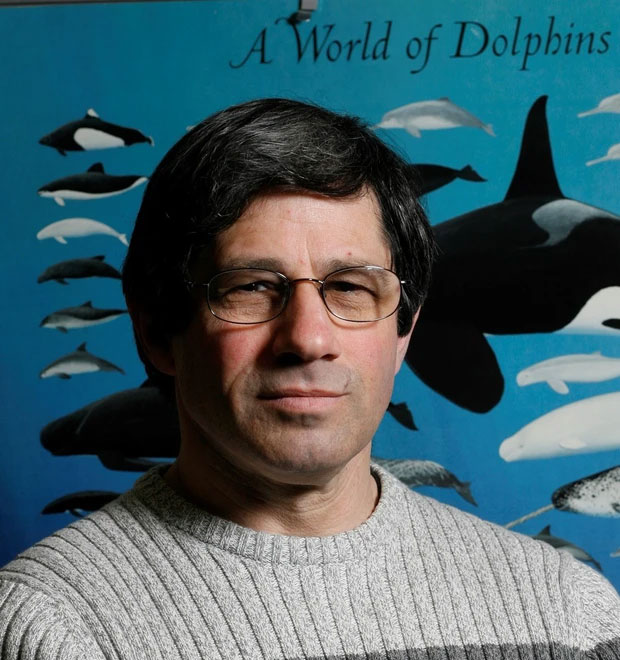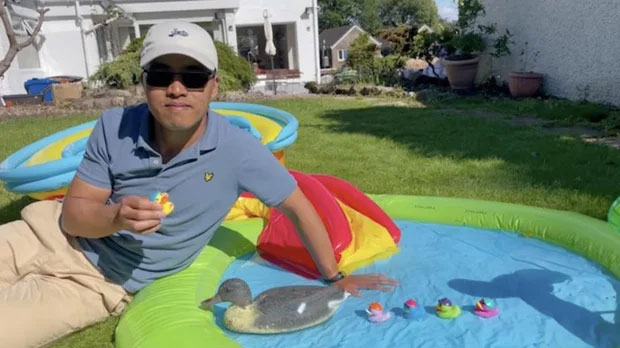Why do ducklings often swim in a row after the mother duck?
Professor Frank Fish, as the name suggests, is very fond of fish and the ocean. In addition, he is also passionate about ducks swimming in the water.
As a biology professor, his research focuses on animal dynamics. In 1994, Professor Frank published an essay on duck swimming behavior, studying the energy expenditure of ducks swimming in groups.

Professor Frank Fish.
However, research on duck swimming behavior does not end there. In 2021, the research team of Chinese professor, Nguyen Chi Minh, published a new thesis on swimming ducks. Both of these studies won the Ig Nobel Prize in physics.
It is known that the Ig Nobel Prize is a parody of the Nobel Prize, awarded in early autumn every year - close to the time when the Nobel Prize is officially announced - for 10 achievements that "first make people laugh, then make them think". The main purpose of the prize is to create a fun atmosphere to encourage research.

Professor Nguyen Chi Minh at the awarding of the Ig Nobel Prize.
What is the attraction of swimming ducks that makes many researchers so fascinated?
Duck swimming "riding waves and surfing"
Those who have watched ducks swim must have seen a few times when the mother duck swims first and the ducklings swim behind, lined up in a straight line. This is not a coincidence, but a coordinated swimming formation of ducks.
The reason why ducks like to swim in rows is still under investigation. But the benefits of swimming in this formation are slowly being discovered. That is energy saving.


In one experiment, researchers calculated metabolic rate by measuring the amount of oxygen consumed by ducks.
During his research, Frank trained several one-day-old mallards to swim in rows with a female duck. Next, the team performed experiments on the growth of the cubs on day 3, day 7, and day 14.
In the results of measuring the metabolism of ducks, the frequency of activity increased but the energy expenditure of each duckling decreased. This experiment proved the correctness of the cause of rowing of ducks from a metabolic perspective.
The reason behind "saving energy" is the wave.
Professor Nguyen Chi Minh's research team focused on observing duck swimming behavior for 7 years, and at the same time established a correlation arithmetic model and discovered the secret of wave oscillations when ducks swim.

Diagram of duck force in still water, same wavelength but different phase. (The green line represents the surface of the water, the blue curve represents the pressure directed towards the duck's body surface, the arrow indicates the direction of the force).
In the "single row formation", when the duckling is in the most suitable position behind the mother duck, the wave resistance will now become "positive" - the direction of resistance is in the same direction as the duckling's swimming direction. At this point the phase of the wave is shown in figure (d) above.
In other words, the resistance now becomes a push from back to front, pushing the ducklings to "ride the waves and surf the wind", helping them swim leisurely. More sophisticatedly, this situation can be maintained by the ducklings in the formation. The first duckling and the second duckling behind the mother are both pushed so they can swim forward in less strenuous conditions. From the third duckling onwards, the force acting on each individual will gradually decrease to zero, thus achieving a dynamic equilibrium.
From that, it can be seen that the large duck swimming first helps the members of the rear flock to spend less effort. This "Wave-riding and Wave-passing" mechanism allows the small ducks to follow the big ducks without being exhausted or obstructed.

This swimming mechanism helps the small ducks swim after the big ducks without being exhausted or hindered.
Ducks save energy, boats save oil
Not only ducks but also boats "swim" in the water. Since ducks are already very intelligent in their movement behavior, humans can't be outdone, of course.
The team from Wuhan University of Technology analyzed different boat formation configurations and found that the total coefficient of resistance of ships moving in a "chaining" pattern was effectively reduced. This means that this model of movement helps boats save more energy.
Thinking a little further, is it possible to apply this principle to all ships in the future? Professor Nguyen Chi Minh's group is researching related concepts, hoping to bring many advancements to the shipping industry.
- 76 long ducklings lined up to swim after her mother causing fever
- Baboons catch prey on prey in front of mother duck
- Ground close to the mother duck to lead the duckling to the extreme straight line, right on the walking line
- 9 facts about ducks that make you fall back
- Be careful with the technology of processing dirty ducklings
- The bizarre duck drank beer like a drink of shocking water
- The way to boil duck is delicious, soft, ripe, not bad
- Do you believe a blanket made of duck hair that costs up to 350 million VND?
- Rare friendship between dogs and ducks
- Should and should not eat duck eggs
- Why don't you learn how to swim forever?
- The duck flies over the Himalayas to breed
 Betray
Betray The most amazing balancing rocks in the world
The most amazing balancing rocks in the world Leaning with a bunch of funny humor on March 8
Leaning with a bunch of funny humor on March 8 The biggest 'biggest', 'the longest' in humans
The biggest 'biggest', 'the longest' in humans